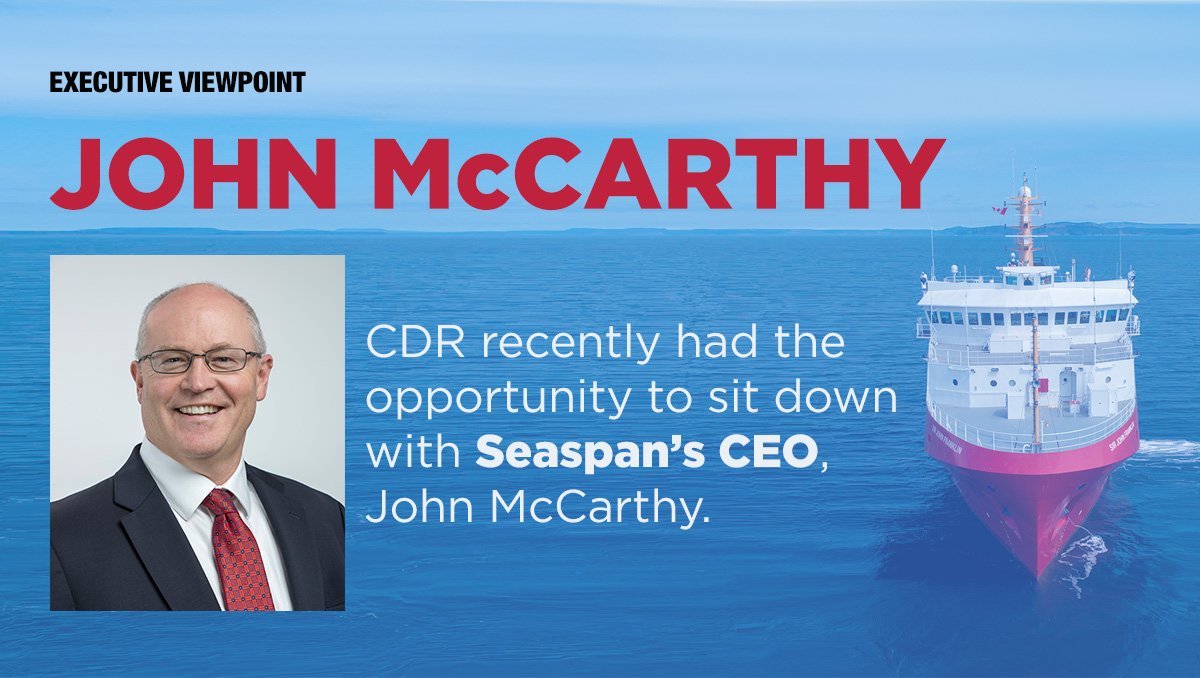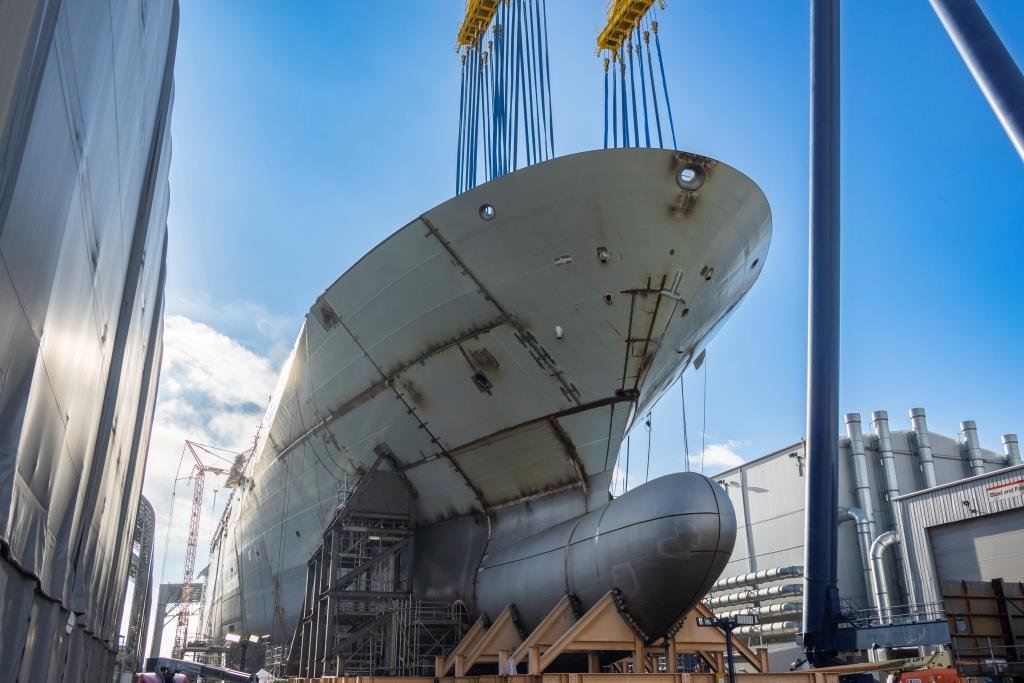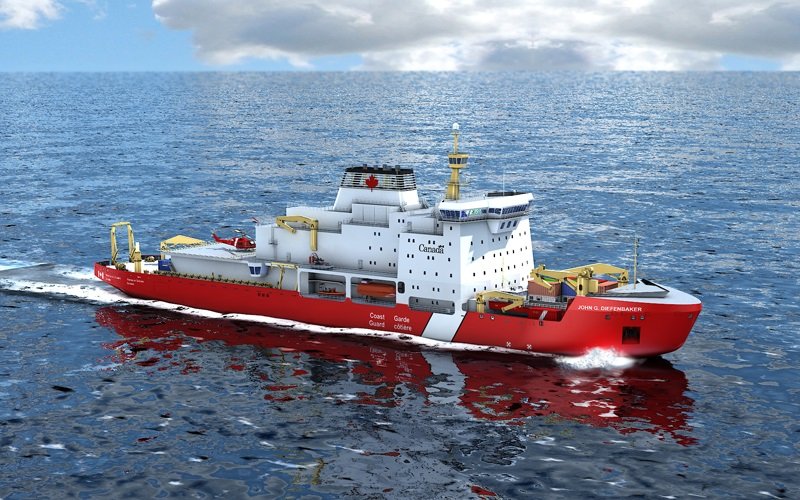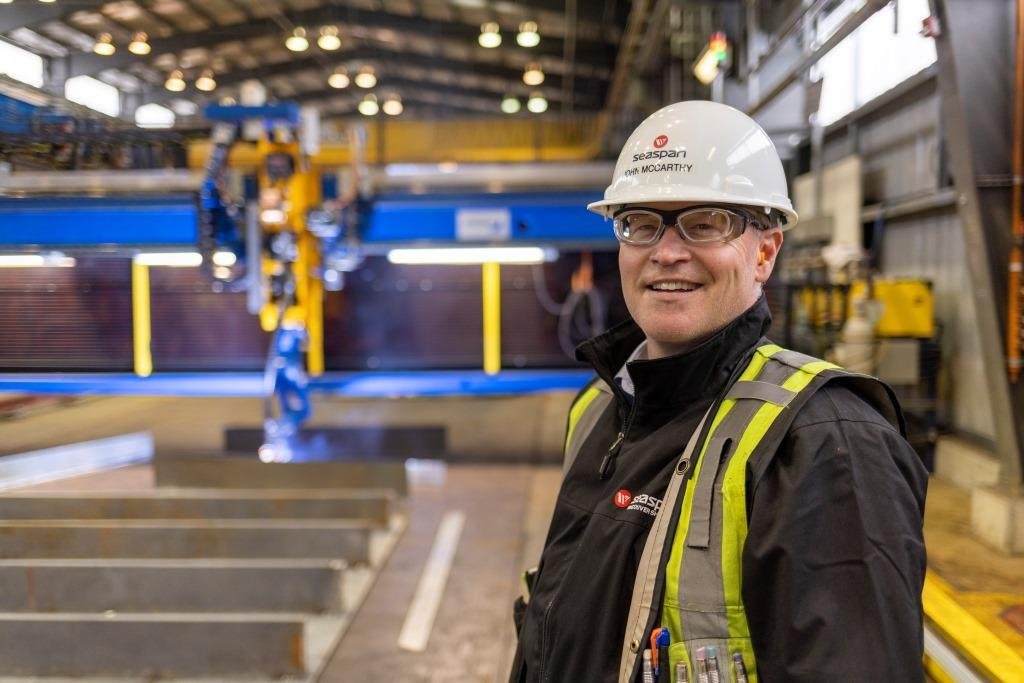EXECUTIVE VIEWPOINT - John McCarthy CEO of Seaspan Shipyards
John McCarthy
CEO of Seaspan Shipyards
 CDR: Mr. McCarthy, thank you for joining me. You’re relatively new to the role of CEO at Seaspan, so what do you feel you can bring to the shipyard that will enable success?
CDR: Mr. McCarthy, thank you for joining me. You’re relatively new to the role of CEO at Seaspan, so what do you feel you can bring to the shipyard that will enable success?
John McCarthy: I have now been at Seaspan Shipyards in a senior leadership role for four and a half years and have been intimately involved in the business, so this is a very natural transition. When you look at my background, I have 37 years in shipbuilding, eight of those in Canada and nearly three decades in the US and international yards building surface combatants. During this time, I was fortunate to have gained experience on 11 lead ship programs in planning, operations, and program management leadership roles.
This background including deep planning and operations experience really helps in terms of 'what does good look like' for our shipyard. And this is one of the big things that I found when I first visited the shipyard about four and a half years ago. Seaspan had a great workforce but they were green — we had not built ships in Canada for the better part of 25 years so bringing that shipbuilding knowledge and expertise into Canada was important.
CDR: Canada's National Shipbuilding Strategy (NSS) is a project which will be decades long, so everyone is looking at timelines. Were previous expectations reasonable when reconstituting a capability?
John McCarthy: I am not sure people would have had patience in the past for saying, hey, it's going to take a decade to get shipbuilding up and running but that is exactly what it takes. And we are only seven years into the journey of building ships in Canada now. It was the same thing in Australia. When you go from a moribund shipbuilding capability, basically non-existent, you need to build up everything: brand new facilities, people, processes, IT systems, and an entire marine industry supply chain. All of that takes time. If you think about it, in 2015, when we finished the $185 million investment out here on the West coast, at no cost to Canada, we had about 50 people. We are now close to 1,850 people just in our new construction yard, so we brought in 1,800 people over the past seven years — it's phenomenal growth but it takes time. As I mentioned earlier, we had no supply chain, but now we are up to over 750 suppliers across Canada with over $2.1 billion in contracts awarded to Canadian suppliers. We have built a vibrant marine industry in Canada, which is a tremendous capability for the nation.
ESCALATING COSTS 
CDR: That's clearly not without hurdles and a lot of people pointing fingers at the costs and delays. People should ask tough questions, but it should be rooted in some appreciation for the ask.
John McCarthy: Cost is very important. But I think the more important question is around the long-term value to Canada which comes with the NSS. If you look at what you might be able to get these vessels for overseas, sure, you could get them at a lower cost but what do you get in return other than a ship? You do not get the pan-Canadian supply chain, you do not get the thousands of good paying jobs in the shipyard and all of our suppliers, or the infrastructure investments within each of the different provinces. You really have to look at long term value across Canada, not just the specific line-item cost of a ship. It is also important to remember that we are building ships that align with Canadian values and specific Canadian requirements. Lastly and perhaps most importantly, Seaspan is now a strategic asset for Canada in supporting our overall national security and sovereignty needs.
CDR: There has been talk about the potential of moving submarine maintenance, specifically of HMCS Chicoutimi away from your facilities at the Esquimalt Graving Dock? Does that concern you?
John McCarthy: There are always discussions around what happens at the Fleet Maintenance Facilities run by the Navy and what we do at the Esquimalt Graving Dock, and we are constantly working with the Navy in terms of that. Our team at Victoria Shipyards has significant submarine experience from participating in the delivery of deep maintenance for the Victoria Class for more than a decade. The current location of our submarine work is directly adjacent to the Royal Canadian Navy’s submarine headquarters, which is located within the Naval Base at Esquimalt. This co-location creates a lot of efficiencies for both the delivery of submarines for maintenance work and acceptance once the work is complete. Between our strategically located facilities and the technical and highly specialized expertise we have developed, Victoria Shipyards is well positioned to continue to deliver submarine maintenance to Canada. It would be tough to replicate this at another site.
STATUS UPDATE
CDR: Let’s do a status update on the vessels you’re currently building and designing under the NSS.
John McCarthy: Sure, our first Joint Support Ship is on the hard stand, and we have the full length of the vessel there. By the end of the first quarter, we will have every block erected and fully consolidated, and that will be launching next year. The Offshore Oceanographic Science Vessel [OOSV] comes in behind that one and is advancing along nicely through our pre-outfit facilities — we have eight blocks out on the hard stand out of 39. By the end of the year, we will have both vessels fully consolidated on the hard stand side by side. To put this in perspective, we also have four first-of-class vessels in the yard — the JSS, the OOSV, and in design we have the Polar Icebreaker, which is now in construction engineering for the Coast Guard, and the MPV [Multi-Purpose Vessel] program is also in design.
CDR: You’ve acknowledged that we can buy ships cheaper than building them in Canada, so why is it important for Canada to continue to invest in NSS?
John McCarthy: Well, as I said a little earlier, we can’t just look at cost. Cost is a huge consideration and component of the calculus, but you must also look at long term value to Canada. The sovereign capability of us to deliver vessels from Canada is important in particular for our national security. Look at what happened with the pandemic when we could not get equipment from overseas, and experts overseas were not able to travel to commission some of our equipment. I think people have started to step back and ask that if we want to have a sovereign capability, and we want to be able to go into the Arctic, are we going to rely on other nations to be able to do that? All of that comes into the overall long-term value to Canada through the NSS. It’s jobs, it’s the supply chain, it’s rebuilding the industry, it's the spin-off of the economic benefits across the country, and it is sovereignty and security of the nation.
AVOIDING BOOM AND BUST
CDR: You mentioned builds for NSS going out to the 2030s, so what then? How do you avoid the ship building “valley of death”?
John McCarthy: When Mark Lamarre and I came out here in 2018, part of our strategy was to build Seaspan and the next generation of Canadian shipbuilding leaders. That was very important to us and today we are doing that right here in North Vancouver. The other big piece was around developing all the skills and the capabilities to design, build, and repair complex ships within Canada, so we can be that sovereign nation. In terms of what happens after the 16 MPVs, we are pushing hard to continue to improve our productivity to become internationally competitive.
CDR: Okay, but history has shown that Canada operates ships well beyond their design life. So, if what is past is prologue, then the ships that Canada is building now will operate for much longer than you’ve got work, so what is your prediction of avoiding another boom/bust cycle?
John McCarthy: I think you need to broaden the scope — the Royal Canadian Navy has big ships, they have combat ships, but they also have smaller ships as well, so we are looking at that from a fleet perspective. We are also looking at other government vessels that are highly complex and densely outfitted that we could build here in Canada. As I mentioned one of our goals is to compete on the international stage and I think that is possible in the 2030s. There are overseas companies that have been building ships for 80 years, so we knew it would take time — we started with 50 people — so I think it will come, Joetey, but it's still going to take some time.
CDR: Do you think Canadian shipbuilders can be competitive on the global scale when you acknowledge that we could buy ships cheaper elsewhere?
John McCarthy: It will take time, and time will tell. Obviously, if Korea is delivering 100 container ships a year, or Damen is delivering 60 ships a year, there is no way from a purely volume perspective that we can ever compete with that. But if you look at the vessels we are good at, which is the highly dense, mission specific and bespoke vessels for the Coast Guard for example, there are other nations that need those types of vessels — that would be the first market that we would go after.
CDR: To what degree did the tugboat worker strike last fall impact your timelines and schedules for NSS related work?
John McCarthy: It was about a seven-week work stoppage where the shipyard workers did not cross the picket lines. That was a seven-week direct impact, but we now have the workforce back and we are starting to rebuild momentum from that. I will say the workforce came back in a very good frame of mind, so we have good morale and are getting back into the drumbeat that we had before. The other good news is we signed a very fair contract with CMSG, the guild, and that was ratified by 90% of their members. And more recently, for the deckhands with the ILWU, we recently signed an agreement which was ratified with a vote of over 90%. The impact to the NSS ships is hard to tell and it all depends on how the momentum looks over the next six months. Like I said, the direct impact was seven weeks, but there's always indirect impacts associated with the ramp down and then ramp back up as you get people back to work.
CDR: Seaspan is building the lion’s share of the non-combat fleet in the NSS. If we look at the cost increases for non-combat ships, what would you extrapolate for the cost of the combat ships which are arguably more complex?
John McCarthy: If you look at the cost of the vessels, our programs pale in comparison to the numbers for CSC. That is out in the public domain. But when people look at our vessels, they should appreciate that they are highly complex. The Royal Canadian Navy does have defensive weapons, so it is part of a combat fleet — that’s important to know, because they can go in harm’s way. But if you look at the Coast Guard vessels, the Coast Guard has to make sure that their vessels can execute a very broad range of missions. When you do that, they become highly dense, they become highly outfitted, and they become highly complex. These vessels at 100 meters for the MPV, 158 meters for Polar, and 89 meters for OOSV are all densely outfitted, and they have very complex communications, bridge navigation systems, buoy tending systems, and fishing and trawling systems. While yes, they do not have combat, they are highly complex. We tend to get compared to foreign ships that are far simpler and/or off-the-shelf. If the Canadian requirements were put in front of a foreign builder, I think that their cost estimates would be significantly higher.
POLAR ICEBREAKERS 
CDR: The build for the two Polar Icebreakers is split between two shipbuilding companies. Does this add complexity to the project, and will it be the same ship coming out of two separate yards or different ships?
John McCarthy: Sharing the Polar Icebreaker does not add complexity to our design or build process at Seaspan, although efficiencies can be found, especially on the design side through information sharing. For a 2-ship program it only makes sense to use a common design but that is not our decision. We are in the construction engineering phase on the Polar Icebreaker, which will be the crown jewel of the Canadian Coast Guard’s fleet. The Polar Icebreaker will help the Canadian Coast Guard sustain a year-round presence in Canada’s North in support of Indigenous Peoples and other northerners, arctic sovereignty, high-Arctic science including climate change research, and the ability to respond to major maritime emergencies. With the support of our supply chain partners, we have built the right team to deliver the new Polar Icebreaker by 2030.
CDR: What initiatives is Seaspan implementing to rein-in costs for your workshare in the NSS?
John McCarthy: There are always challenges and learnings with first-of-class vessels, but we are constantly improving our processes to find greater efficiencies on the design and engineering side and through construction and this requires an ongoing investment from Seaspan. For example, we recently invested $30 million in our infrastructure for our steel production and assembly facilities and other construction units, including our Welding Centre of Excellence. That is where we will qualify our welding processes to weld thicker high-strength steel required for the Polar Icebreaker.
CDR: Thank you.
Joetey Attariwala is CDR’s Senior Staff Writer


